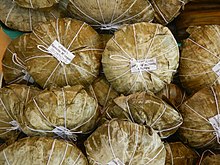
Poi is a traditional staple food in the Polynesian diet, made from taro.
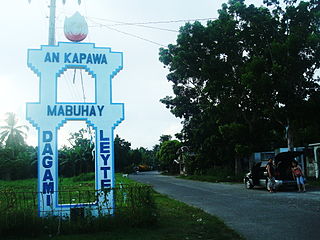
Dagami, officially the Municipality of Dagami, is a 3rd class municipality in the province of Leyte, Philippines. According to the 2020 census, it has a population of 36,178 people.

Taro is a root vegetable. It is the most widely cultivated species of several plants in the family Araceae that are used as vegetables for their corms, leaves, stems and petioles. Taro corms are a food staple in African, Oceanic, East Asian, Southeast Asian and South Asian cultures. Taro is believed to be one of the earliest cultivated plants.

Filipino cuisine is composed of the cuisines of more than a hundred distinct ethnolinguistic groups found throughout the Philippine archipelago. A majority of mainstream Filipino dishes that compose Filipino cuisine are from the food traditions of various ethnolinguistic groups and tribes of the archipelago, including the Ilocano, Pangasinan, Kapampangan, Tagalog, Bicolano, Visayan, Chavacano and Maranao ethnolinguistic groups. The dishes associated with these groups evolved over the centuries from a largely indigenous base shared with maritime Southeast Asia with varied influences from Chinese, Spanish and American cuisines, in line with the major waves of influence that had enriched the cultures of the archipelago and adapted using indigenous ingredients to meet local preferences.

Halo-halo, also spelled haluhalo, Tagalog for "mixed", is a popular cold dessert in the Philippines made up of crushed ice, evaporated milk or coconut milk, and various ingredients including side dishes such as ube jam, sweetened kidney beans or garbanzo beans, coconut strips, sago, gulaman (agar), pinipig, boiled taro or soft yams in cubes, flan, slices or portions of fruit preserves and other root crop preserves. The dessert is topped with a scoop of ube ice cream. It is usually prepared in a tall clear glass and served with a long spoon. Halo-halo is considered to be the unofficial national dessert of the Philippines.
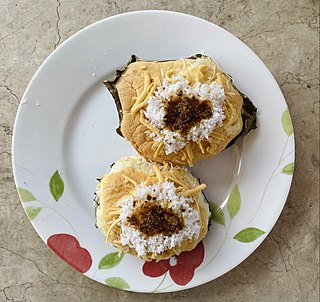
Bibingka commonly refers to a type of baked rice cake from the Philippines that is traditionally cooked in a terracotta oven lined with banana leaves and is usually eaten for breakfast or as merienda especially during the Christmas season.

Kalamay, is a sticky sweet delicacy that is popular in many regions of the Philippines. It is made of coconut milk, brown sugar, and ground glutinous rice. It can also be flavored with margarine, peanut butter, or vanilla. Kalamay can be eaten alone but is usually used as a sweetener for a number of Filipino desserts and beverages. It is related to the Chamorro dessert called Kalamai.

Laing, is a Filipino dish of shredded or whole taro leaves with meat or seafood cooked in thick coconut milk spiced with labuyo chili, lemongrass, garlic, shallots, ginger, and shrimp paste. It originates from the Bicol Region, where it is known simply as pinangat. Laing is also a type of ginataan, and thus may also be referred to as ginataang laing. Laing is commonly eaten as a vegetable side to complement meat or fish side dishes known as ulam in Filipino, which is normally paired with boiled white rice.

Benegnet is a Visayan dessert soup from the central Philippines. The dish is traditionally made with glutinous rice cooked in coconut milk with various slices of sabá bananas, taro, ube, and sweet potato, among other ingredients. It is comparable to various dessert guinataán dishes found in other regions such as bilo-bilo. Among the Visayan people, the dish is traditionally served during Good Friday of Holy Week.

Cyrtosperma merkusii or giant swamp taro, is a crop grown throughout Oceania and into South and Southeast Asia. It is a riverine and "swamp crop" similar to taro, but "with bigger leaves and larger, coarser roots." There are no demonstrably wild populations today, but it is believed to be native to Indonesia. It is known as puraka in Cook Islands, lak in Yap, babai in Kiribati, iaraj in the Marshall Islands, brak in Palau, babaʻ in the Marianas Islands, pula’a in Samoa, via kana, Pulaka in Lau, Lovo in Fiji, pulaka in Tokelau and Tuvalu, mwahng in Pohnpei, pasruk in Kosrae, simiden in Chuuk, swam taro in Papua New Guinea, navia in Vanuatu and palawan in the Philippines.

Sticky rice in bamboo is a common Southeast Asian dish consisting of sticky rice roasted inside specially prepared bamboo sections of different diameters and lengths. It is consumed both as a savory food and as a sweet dessert.
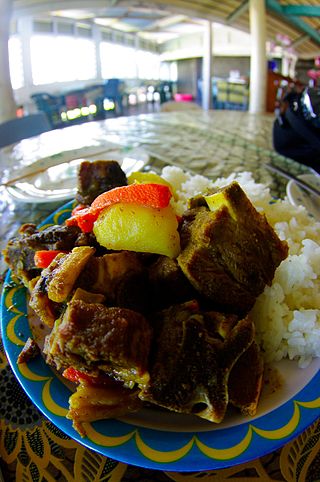
The cuisine of Tuvalu, a state in the Central Pacific (Oceania), is based on the staple of coconut and the many species of fish found in the ocean and the lagoons of the atolls of Tuvalu. Pulaka,, or swamp taro, is an important source of carbohydrates. Rice now forms an important part of the diet. Coconut is used in different forms with coconut water, coconut milk and the flesh of the coconut being used to flavour dishes. Various desserts made on the islands include coconut and coconut milk, instead of animal milk.
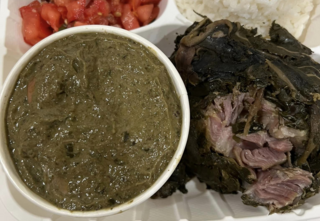
Lūʻau, Luʻau, Laulau, Lū, Rourou, Rukau, Fāfā, Hāhā, and Palusami are all related dishes found throughout Polynesia based on the use of taro leaves as a primary ingredient. While taro generally is known as a root vegetable for its starchy corms, the leaves are consumed as well. The base recipe is vegetarian. Most often, coconut milk was added, and later meat or seafood. The texture of the dish range from a thick soup to a dense cake.
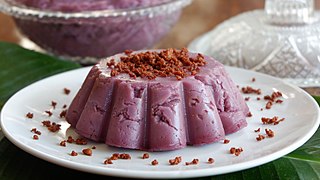
Ube halaya or halayang ube is a Philippine dessert made from boiled and mashed purple yam. Ube halaya is the main base in ube/purple yam flavored-pastries and ube ice cream. It can also be incorporated in other desserts such as halo-halo. It is also commonly anglicized as ube jam, or called by its original native name, nilupak na ube.
Ancient diet is mainly determined by food's accessibility which involves location, geography and climate while ancient health is affected by food consumption apart from external factors such as diseases and plagues. There are still a lot of doubt about this ancient diet due to lack of evidence. Similar to what anthropologist Amanda Henry has said, there are a lot of time periods in the human history but there are only theories to answer questions on what people actually ate then. Only recently have traces been discovered in what was left of these people.

In Filipino cuisine, moron is a rice cake similar to suman. It is a native delicacy of the Waray people in the Eastern Visayas region of the Philippines, particularly in the area around Tacloban City in the province of Leyte and in Eastern Samar province. Other parts of the Philippines have their versions of it, however. In fact, the moron was adopted as one of Mambajao, Camiguin's locally produced products.
Sayongsong is a traditional Filipino steamed rice cake from Surigao del Norte and other areas of the Caraga Region of northeastern Mindanao, as well as the southeastern Visayas where it is known as sarungsong or alisuso. It is distinctively served in cone-shaped banana leaves. Sayongsong is a type of puto.
Binakol, also spelled binakoe, is a Filipino chicken soup made from chicken cooked in coconut water with grated coconut, green papaya, leafy vegetables, garlic, onion, ginger, lemongrass, and patis. It can also be spiced with chilis. Binakol can also be cooked with other kinds of meat or seafood. It was traditionally cooked inside bamboo tubes or directly on halved coconut shells. The dish originates from the Western Visayas, particularly the province of Aklan.

Nilupak is a class of traditional Filipino delicacies made from mashed or pounded starchy foods mixed with coconut milk and sugar. They are molded into various shapes and traditionally served on banana leaves with toppings of grated young coconut (buko), various nuts, cheese, butter, or margarine. It is also known as nilusak, linusak, niyubak, linupak, or lubi-lubi, among many other names, in the various languages of the Philippines. It is also known as minukmok in Quezon.
